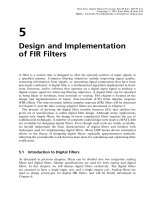Chapter 5: LANs and WLANs pptx
Bạn đang xem bản rút gọn của tài liệu. Xem và tải ngay bản đầy đủ của tài liệu tại đây (1.56 MB, 49 trang )
LANs and WLANs
LANs and WLANs
Chapter 5
Chapter 5
5
Chapter 5: LANs and WLANs 2
Chapter Contents
Section A: Network Building Blocks
Section B: Wired Networks
Section C: Wireless Networks
Section D: Using LANs
Section E: Security Through Encryption
5
Chapter 5: LANs and WLANs 3
Network Classifications
Personal Area Network (PAN) – interconnection of
personal digital devices
Neighborhood Area Network (NAN) – connectivity
spread over several buildings
Local Area Network (LAN) – usually connects
computers in a single building – this is the one
most people have heard of
Metropolitan Area Network (MAN) – public high-
speed network with range of about 50 miles
Wide Area Network (WAN) – consists of several
smaller networks
5
Chapter 5: LANs and WLANs 4
Network Devices
Each connection point on a network is referred to as
a node
To connect to a LAN, a computer requires network
circuitry, sometimes referred to as a network
interface card (NIC)
A networked peripheral, or network-enabled
peripheral, is any device that contains network
circuitry to directly connect to a network
A network device, or network appliance, is any
electronic device that broadcasts network data,
boosts signals, or routes data to its destination
5
Chapter 5: LANs and WLANs 5
Network Devices
5
Chapter 5: LANs and WLANs 6
Clients, Servers, and Peers
Network devices can function as clients or as servers
–
Application server
–
File server
–
Print server
Networks that include one or more servers can operate
in client/server mode
5
Chapter 5: LANs and WLANs 7
Physical Topology
The arrangement of devices in a network is referred to as its
physical topology
–
Star
–
Ring
–
Bus
–
Mesh
–
Tree
Two similar networks can
be connected by a device
called a bridge
Gateway is a generic term
for any device or software
code used to join two networks
5
Chapter 5: LANs and WLANs 8
Network Links
A communications channel, or link, is a
physical path or frequency for signal
transmissions
Bandwidth is the transmission capacity of a
communications channel
–
Broadband
–
Narrowband
5
Chapter 5: LANs and WLANs 9
Communications Protocols
Rules for efficiently transmitting data from
one network node to another
–
Divide messages into packets
–
Affix addresses to packets
–
Initiate transmission
–
Regulate flow of data
–
Check for transmission errors
–
Acknowledge receipt of transmitted data
5
Chapter 5: LANs and WLANs 10
Communications Protocols
A packet is a “parcel” of
data that is sent across
a computer network
–
Circuit-switching
technology vs. packet
switching technology
•
Voice over IP (VoIP)
5
Chapter 5: LANs and WLANs 11
Communications Protocols
Every packet that travels over a network
includes the address of its destination device
A MAC address is a unique number assigned
to a network interface card when it is
manufactured
An IP address is a series of numbers used to
identify a network device
IP addresses can also be obtained through
DHCP
5
SECTION
B
Chapter 5: LANs and WLANs 12
Wired Networks
Wired Networks
Wired Network Basics
HomePNA and Powerline Networks
Ethernet
Ethernet Equipment
Ethernet Setup
5
Chapter 5: LANs and WLANs 13
Wired Network Basics
A wired network uses cables to connect
network devices
Wired networks are fast, secure, and simple
to configure
Devices tethered to cables
have limited mobility
5
Chapter 5: LANs and WLANs 14
Ethernet
Simultaneously broadcasts data packets to
all network devices
–
IEEE 802.3
–
CSMA/CD protocol
Vary in speed from 10Mbps to 10Gbps
5
Chapter 5: LANs and WLANs 15
Ethernet
On an Ethernet, data
travels on a first come,
first served basis. If two
workstations attempt to
send data at the same
time, a collision occurs.
That data must be
resent.
5
Chapter 5: LANs and WLANs 16
Ethernet Equipment
Checking a workstation
for an Ethernet port
5
Chapter 5: LANs and WLANs 17
Ethernet Equipment
Ethernet adapter (designed to support the
Ethernet protocols)
Network hub
Network switch
Network router
RJ45 connector
5
Chapter 5: LANs and WLANs 18
Ethernet Setup
5
Chapter 5: LANs and WLANs 19
Ethernet Setup
5
Chapter 5: LANs and WLANs 20
Ethernet Setup
The Network Connection window helps you
check your connection
5
SECTION
C
Chapter 5: LANs and WLANs 21
Wireless Networks
Wireless Networks
Wireless Basics
Bluetooth
Wi-Fi
Wi-Fi Equipment
Wi-Fi Setup
5
Chapter 5: LANs and WLANs 22
Wireless Basics
A wireless network transports data from one
device to another without cables or wires
–
RF signals
•
Transceiver
–
Microwaves
–
Infrared light
Slower than wired networks
Security concerns
5
Chapter 5: LANs and WLANs 23
Bluetooth
Bluetooth is a short-range, wireless network
technology designed to make its own
connections between electronic devices,
without wires, cables or any direct action from
a user
5
Chapter 5: LANs and WLANs 24
Wi-Fi
Wireless networking technologies that are
compatible with Ethernet
MIMO technology uses two or more
antennae to send multiple sets of signals
5
Chapter 5: LANs and WLANs 25
Wi-Fi Equipment









